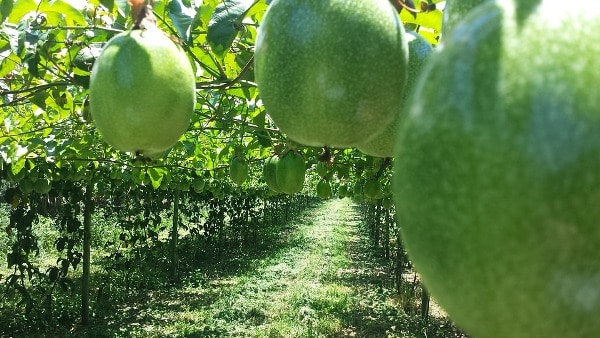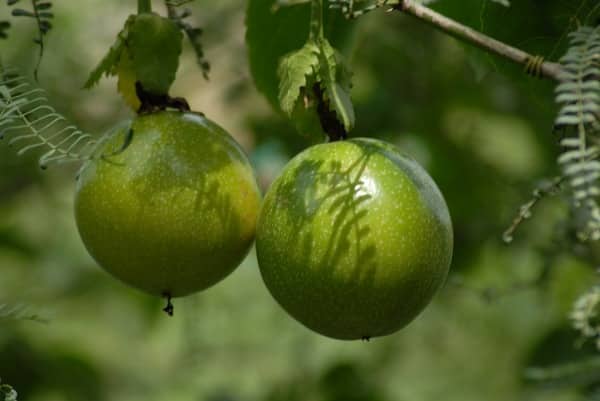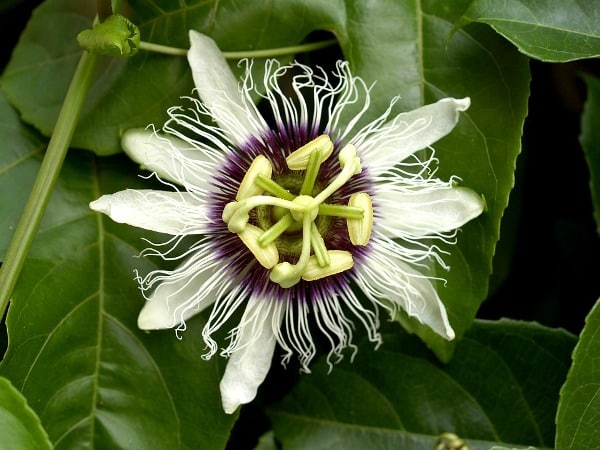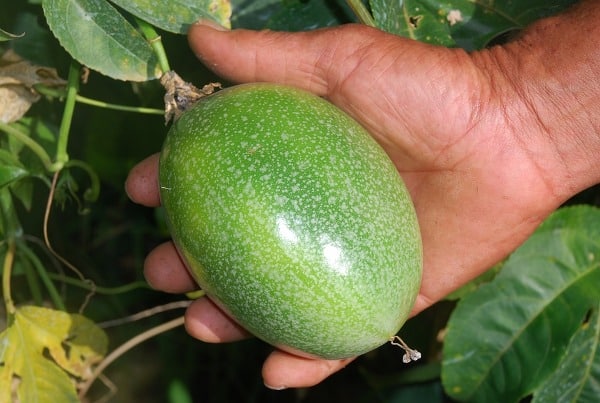Introduction to Passion Fruit Cultivation
The following guide explains about: How To Grow Passion Fruits or Passion Fruit Cultivation.
The passion fruit (Passiflora edulis) belongs to the family of Passifloraceae, this fruit is native of Brazil. The fruit has great flavor and aroma which helps not only in producing a high-quality squash, but also in flavoring several other products.
This is a perennial plant that grows vigorously, this planthaswoody vine that produces a round or ovoid fruits. The Passion fruit has a tough, smooth, waxy dark purple/yellow colored rind with faint, fine white specks. Passion fruits have orange colored flesh with juicy and pulpy flesh, which contains a large number of small, hard, dark brown to black pitted seeds. These fruits not recommended for table purpose. When these fruits are processed they get a unique flavor and aroma and high nutritional and medicinal properties. The juice of passion fruit with an excellent flavor is quite delicious, nutritious and liked for its blending quality. To enhance the flavor of the final product, passion fruit juice is often mixed with juices of pineapple, mango, ginger, etc. The juice of passion fruit is used in used in confectionery and preparation of cakes, pies and ice cream. It is a rich source of Vitamin A and contains fair amounts of Sodium, Magnesium, Sulphur and Chlorides.
Climate and Soil Requirements for Passion Fruit Cultivation
Passion fruit grown well in tropical to subtropical humid climate and it grows well in the regions up to 2000 m altitude with an annual rainfall of 1000 to 2500 mm. A commercial passion fruit cultivation requires an optimum temperature of 20 °C to 30 °C and temperatures below 15 °C will control the vegetative growth and flowering. The crop gives good productivity in light sandy loam soils with a pH of 6.0 – 7.0 and good drainage. A soil having enough quantity of moisture, rich in organic matter and low in salts is considered very suitable for its cultivation. Passion Fruit likes tropical and sub-tropical climate with moderate rainfall ranging between 100 and 250 cm.

For purple passion fruit cultivation, it prefers cool temperatures for flower initiation and fruit set (18-23°C), while relatively high temperatures seem necessary for promoting juice production (18-23°C) and improvement in quality.
For Yellow passion fruit cultivation, it requires lowland tropical conditions, while, the purple type tends more to be cultivated in subtropical areas or at higher altitudes in the tropics. The lowest temperature can affect the fruiting of the vines and upper parts suffered cold injury. Passion fruit crop generally requires an average annual rainfall of 100 cm. In Asia, it grows in areas of receiving rain from between 100 cm and 250 cm.
Passion Fruit Varieties for Passion Fruit Cultivation
There are many species of Passiflora in the family of Passifloraceae, but only one Passiflora edulis Sims, is commonly known as passion fruit. There are two different forms of Passion Fruit, the standard yellow and the purple passion fruit, the only main difference is in acidity and starch content. The yellow passion fruits are more acidic and less starchy while the purple passion fruits are less acidic and starchier. Both two varieties, viz., purple Passion Fruit (P. edulis) and yellow Passion Fruit (P. edulis var. flavicarpa) are used for commercial farming. The hybrid varieties of passion fruits of the above passion fruit varieties are also being developed for commercial cultivation.
And among these wide varieties of species, only Purple passion fruit (Passiflora edulis Sims), Yellow Passion Fruit (Passiflora edulis var. flavicarpa) and ‘Kaveri’ Hybrid passion fruit (Purple x Yellow) is widely cultivated in tropical and sub-tropical regions.
Purple Passion Fruit
Purple passion fruits are vined, the vines are highly productive at higher elevations. Purple Passion Fruits are 4-5 cm in diameter, they will turn to a deep purple when they ripen, each fruit weighs 35-45 g. The juice content of the fruit varies from 31-35 per cent. This purple passion fruit variety is known for its quality in terms of flavor and nutrient content. There are plenty of seeds at the center in black in color. This variety passion fruits are susceptible to leaf spot, collar rot, attack by thrips and nematodes.
Yellow Passion Fruit
This passion fruit variety is suitable for farming in the lower elevations and these is temperature sensitive and are less productive at higher elevations. The size of the yellow passion fruit is very bigger in size than purple passion fruit variety, and each yellow passion fruit weighs about 60 g, and these fruits will be in a round shape with yellow mottled spots, turns golden yellow when ripe. Juice of yellow passion fruit is more acidic, its recovery being comparatively less than the purple. Seeds of yellow passion fruits are brown in color, this passion fruit variety resistant to leaf spot and wilt, escapes the damage by thrips and tolerant to nematodes.
Kaveri Hybrid Passion Fruit
This is a cross hybrid variety between Purple and Yellow passion fruit. It is a highly productive variety and each fruit weighs 85-110 g. The fruits are purple in color, fruit quality comparable to that of Purple variety. This passion fruit varieties are resistant to brown leaf spot, collar rot, wilt and nematodes.
Propagation of Passion Fruit Plants
Passion fruit is propagated from seeds, cuttings and grafting. Grafting is done on resistant root stocks. Seedlings and grafted plants grow vigorously than cuttings.
Propagating Passion Fruits from Seeds:
For seeds, collect the Passion Fruits from superior vines that give high yield with quality. The pulp should be extracted and fermented for 72 hours and then the seeds are extracted. The seeds should be sown in well treated seed beds during March-April. After germination, once the seedlings appear with 4-6 pairs of true leaves, at this stage seedlings should be transplanted in, 10 cm x 22 cm poly bags filled with a mixture of soil, compost and sand (2:1:1). The seedlings will be ready for transplanting in the main field after three months.
Propagation by Grafting:
Grafting is a method used to multiply hybrid varieties to create disease resistant varieties. The yellow passion fruit is highly resistant to nematode infestation and diseases and found to be a good rootstock for hybrid varieties.
The seed of yellow passion fruits should be can be sown either in March or in October for raising the seedling depending upon the availability of the seed. Seedlings should be sown on seedbed or in pots. The plants became ready for grafting in 3 months.
Select the scions from healthy young vines from mature plants. Both the stock and scion should be of pencil thickness for grafting.
The diameter of the selected scion and diameter of rootstock should be same. Cleft graft, whip graft or side wedge graft methods are used for grafting.
Vegetative Propagation of Passion Fruit:
Collect Semi-hardwood cuttings of about 30-35 cm size with 3-4 nodes are ideal from the healthy plants. First place the cuttings in the sand beds/pots for root initiation and then transfer them into poly bags for better root development. The cuttings take more than three months for root development, the cutting get ready for planting in about three months. Many commercial farmers raise the plant from the seeds and vegetative propagation is not very common as it is time consuming.
Spacing and Planting in Passion Fruit Cultivation
The spacing in passion fruit farming will vary depending upon the type of training system being followed and variety. In a Kniffin system of training the spacing should be 2m x 3m, which will accommodate1666 plants/ha. In bower system, the recommended spacing is 3m x 3m which can accommodate about 1110 plants/ha.
Preparation of Land:
- Avoid planting in the sites experiencing high winds, as the vines of the plants will damage due to the wind. The wind makes it more difficult to train the vines to the trellis.
- Dig Pits of 45 cm x 45 cm x 45 cm at a spacing of 3m x 2m, on hill slopes/plains. Fill the pits with a mixture of three parts of top soil and one part of compost and planting is done preferably on cloudy days during May-June after onset of monsoon.
- You can grow seasonal vegetables as intercrops during the first year.Turmeric and ginger are the best intercrops by supplementing the nutrition.
Training and Pruning in Passion Fruit Cultivation
Training is very important for regulating yield and it also gives support to the vine during its economic life. Weak and faulty construction of trellis may cause sagging and loss of vines.
Training:
The vines of the plants are trained to a single unbranched shoot from the base of the plant up to the trellis height and from this point, two vigorous shoots can grow on the trellis in opposite directions. In due time, the laterals that grow from the primaries are trained by hanging downwards from the wire and the tendrils come should be pruned periodically. These laterals will lead to the potential fruit bearing area of the vines. Trellising is an important part in obtaining a maximum potential yield of passion fruit. The kniffin system is the most economical training method, in which 2.5 m long posts/pillars are erected 3 m apart and four lines of 9 to 11-gauge wire can run across.
The trellis will run across the slope or in North-South direction, this gives maximum and even exposure of the vines to sunlight. If using wooden posts, they must be painted with coal tar at the base to avoid insect attack and quick rotting. Telephone system on raisers are also more economical as it allows growing intercrops on terraces and suppressing the weed growth. The bower system of training is also followed in some regions.
Intercultural operation of Passion Fruit Cultivation:
Passion fruit plants are shallow rooted, having most of the feeder roots within 15 cm of the soil surface requires light digging.
Deep digging should be avoided and weed growth should be checked constantly by surface weeding or by scraping and scuffling. Mulching with dried leaves or grass will restore moisture during the summer months.

Pruning in Passion Fruit Cultivation:
Systematic pruning of vine encourages new growth, which resulting in regular and higher yield of fruits. After the harvest of the crop, the laterals should prune to 4-5 buds. Pruning should be done in April and December after harvesting of the crop.
Manuring in Passion Fruit Cultivation
- Applying organic manure is highly needed to have vigorous growth of plants in regular and optimum yield. Many commercial passion fruit plantations grow passion fruit by using organic inputs like farmyard manure, vermicompost, bio-plus (prepared from organic waste), etc. even oil cake is applied in some areas. In the first year of plantation, 10 kgs of FYM (farm yard manure) per vine and from second year onwards 15 kg of FYM (farm yard manure) per vine are recommended. Mixtures of farm yard manure and vermicompost in the ratio 4:1 or 3:1 and oil cake gives good yields. The manure should be applied in February-March.
- The nutritional requirements of passion fruit,for optimum fruit yield and to improve the longevity of passion fruit vine and to recommend an optimum dose of fertilizer for the crops were : 202.5 kg N – 17.4 kg P, 184.2 kg K – 151.6kg Ca – 14.4 kg Mg – 25.0 kg S – 770. 4 g Fe, 2810.2 g Mn, 198.7 g Cu – 316.9 g Zn –295.8 g B.
- This requirement may vary according to the fertility of the soil. A fertilizer dose of 110g N, 60g P2O5 and 110g K2O per vine per annum is recommended for the 4-year-old plantations in southern regions. For Kaveri hybrid variety passion fruits, 100g N, 50g P2O5 and 100g K2O per vine per annum is recommended. While 80g N, 40g P2O5 and 50g K2O per vine per annum is recommended for the 4-year-old plantation in Northern regions.
- Three 3 splits dozes Nitrogen should be applied in the months of February-March, July-August and October -November along with farmyard manure evenly spread in a circle of 50-45 cm radius about the stem having enough moisture in soil at the time of fertilizer application to ensure better use efficiency, while potash should be given in the two split doses. In addition to this, 2-3 sprays of 5% Urea can be given during the summer months. The foliar application of micronutrients is recommended for deficient areas.

Irrigation requirement for Passion Fruit Cultivation
- Long dry spell periods during January-March will reduce main summer crop production and may also affect adversely the development of flowering laterals. If there is no rainfall during the dry months, supplementary irrigation is compulsory at fortnightly intervals.
- A passion fruit crop requires irrigation of 12-15 liter /vine/day in summer and 6-8 liter /vine/day in
- Drip irrigation System is also very useful. Passion fruit vine responds significantly to fertigation.
Pests and Diseases in Passion Fruit Cultivation
Pests
- Fruit flies are most common pests that affect passion fruit crops. The fruit fly will puncture the young fruits during development. When passion fruit is effected with fruit flies, Fruits become woody, deformed and the pulp content is reduced.
- Thrips are also some common pests that affect passion fruits. Thripslay larva on the buds and developing fruits. Affected fruits will be deformed and the weight of the fruit and juice content of the fruit will be reduced. The effect of thrips will be severe in summer crop. Mites will eat the young leaves and tender fruits. It leads to defoliation and the formation of undersized fruits.
Diseases
- Brown spot disease is caused due to Alternaria macrosporaSimes. The disease created brown spots with greenish margin on the leaves. Girdling of branches and premature defoliation occurs when the effect of the disease is severe. Regular inspection is required, and the affected branches should be pruned and burnt.
- Root Rot is caused by hytophthoranicotianae. The roots of the plants affected by root rot will die ultimately. Applying 1 % Bordeaux mixture helps in checking the disease. The affected plants should be raised above with the soil to encourage new root formation.
- Wilt or Collar rot, is a severe disease caused by Fusarium oxysporum/ F. passiflorae. The affected plants die immediately. There are no particular techniques to control diseases, the only best technique is to select tolerant/resistant varieties or use of resistant root stocks.
Harvesting

The vines of the plant start producing fruits after 10 months of planting and bearing reaches optimum by 16-18months. August to December and March to May are the two main periods of fruiting. Fruits take 80-85 days to get ready. Slightly purple colored fruits along with a small portion of the stem / periodical should be harvested. If fruits are stored for long periods, storing for periods lead to loss in weight and their appearance. The cover may become wrinkled on drying, but the pulp remains in good condition for several days.
Post-harvest Handling and Marketing:
The Fruits harvested should be disposed immediately, to prevent the loss in weight and appearance. Storage causes 10-20% loss in fruit weight, and fruits wrinkle and give a bad appearance. To avoid this, store them in polythene bags and for transport to distant markets polyethylene-lined crates can be used.
Yield of Passion Fruits
An average yield of purple variety is 8-10 t/ha and that of the hybrid Kaveri is 16-20 tons/ ha. An yield of 7 to 9 kg or 200 to 250 fruits per vine is generally obtained every year.

Sir thanks for the wonderful write up. Can you please tell in Bhopal, M.P where can we get seeds or saplings and initial investment cost etc.
Sir, Can you kindly recommend a nursery where we can purchase dwarf variety of Jamun plants which are short in nature. Thank-you